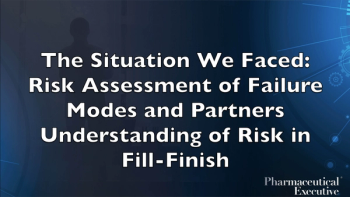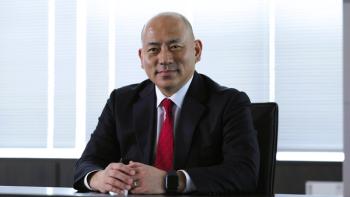
Better Prepared for Unpredictability: Al Altomari, Agile Therapeutics
Agile Therapeutics' CEO Al Altomari talks about his decade of leadership at the company and the process of launching a new product during COVID-19.
Women's healthcare company Agile Therapeutics (Princeton, NJ) develops product and product candidates designed to provide women with contraceptive options that offer freedom from taking a daily pill, without committing to a longer-acting method. December 2020 saw the US commercial launch of Agile's initial product, Twirla, a non-daily, non-invasive contraceptive patch.
Al Altomari has served as Agile’s Chairman of the board and Chief Executive Officer since October 2016. He served as President and CEO from 2010 to 2016. Altomari talks to Pharm Exec about his decade of leadership at Agile and about Twirla’s potential in the area of women’s health.
PharmExec: What advance does Agile’s new treatment, Twirla, represent in the area of women’s health?
Al Altomari: At Agile, along with most healthcare experts in family planning, we believe in access first and foremost. Secondly, having options is a critical part in deciding what birth control may work best for a woman, and Twirla is an important choice for them to be aware of. What works for one woman may not work for another. Where we have seen a need in the marketplace is that birth control options are still overwhelmingly in the form of either daily birth control pills, or longer acting methods like IUDs, vaginal rings, and injections, amongst others. Those longer acting options are more permanent and more difficult for women to use and manage, often requiring more physician intervention. With that, we think there is a void between the daily and longer acting birth control choices, and we think Twirla, a once-weekly patch, fits into that.
Twirla is the lowest-dose hormonal contraceptive patch available, so we feel like we are meeting a lot of the needs for women deciding on a birth control option.
What were the challenges and opportunities associated with launching a new product during the COVID pandemic?
I would like to start with our opportunities. We have found that physicians, particularly thought leaders, are more available to us. Pre-COVID, if you were a thought leader or wanted to come to a scientific advisory board or work with a company, you had to travel around and lose time with your family and your patients — it was a larger sacrifice. We are finding now that we can tap into our nation’s thought leaders virtually — either directly from the company’s perspective or make them available to speak with other doctors to have important discussions. This has been a wonderful opportunity for Agile and has created an environment of togetherness. Another pleasant surprise has been how easy it is for a sales representative to at-least get in front of a doctor, and I’ve been pleasantly surprised by how receptive our audience has been to seeing us.
In terms of challenges, the biggest has been for our sales team with the quality of the interactions. Whether it is virtual or if they are safely able to get into a clinician's office, the COVID-19 protocols can be challenging when having those discussions — they are short and the number of providers you are able to interact with is obviously limited.
So the good news is that there is more frequency, the bad news is that the quality of the interaction is down. The biggest challenge with COVID-19 for our sales team has been the unpredictability of it. At the end of the day, it is a regional sales challenge, with changes to state legislation and guidelines so there is a bit of chasing constantly changing guidelines to get our sales reps in the door. At Agile, we have learned that this could happen again, in that COVID-19 is a business interruption that we are seeing play out. Whether it is COVID-19 or a regional shutdown due to weather, there are always going to be business interruptions, and we’ve been reflecting on how to be better prepared for unpredictability.
What education initiatives do you have in place around Twirla and why is education so important?
When it comes to choices in birth control products for women, the options can seem both overwhelming and intimidating when you are not armed with the right information. To help this, Agile has launched the I’m So Done awareness campaign. The campaign leverages social media and influencers to drive women to the BirthControlDoneMyWay.com website1 where they can tap into educational resources around all available birth control options, join and engage in a community of women sharing their own birth control experiences, and get tips on having an informed and confident conversation with their doctor.
Education specifically surrounding Twirla is essential, given that the first contraceptive patch on the market resulted in controversy related to the amount of estrogen it ultimately released, and physicians lost trust in the idea of the patch. But Twirla, as the lowest-dose hormonal option in birth control patches deserves a place as a first-line contraceptive therapy. Before Twirla, if a woman were to go to her doctor and say she wanted to go on birth control for the first time, our research shows that she would most likely be offered low dose birth control pills, potentially a ring, or an IUD. Those are the big three mainstream options, so we have got to earn the right to get into that conversation that a patch is first line again. Many doctors of this generation have not been trained on contraceptive patches, so in a lot of ways we are reintroducing the patch to doctors and young women. Additionally, as I mentioned previously, we are able to better tap into and access some of the nation’s thought leaders in family planning and contraception and engage them in virtual speaker bureau and key opinion leader events. During a time where fewer and fewer physicians are allowed to interact with reps due to the pandemic, virtual speaker events feed the prescriber's appetite to learn about Twirla directly from their respected peers who have used and believe in the product.
What drew you to the women’s health space, and what makes this category different from other therapeutics?
What attracts me to this category and sets it apart from others is that women are fantastic partners in healthcare. They are much more engaged and proactive in their healthcare, by going to their doctor multiple times a year and being more aware of the state of their health than their male counterparts can be. Women continually seek new information and, as a marketer, having someone engaged and caring about the product is a wonderful advantage.
You’ve overseen a decade of growth at Agile. What have been the highs and lows of the last 10–11 years for you on this journey?
The highs and lows for us have been part of the same journey, which was the regulatory path for us. Our company took on a very complex trial, that has never been done before, and as close to a real-world trial, including women of all races, ethnicities, and body sizes. While including these women may seem so obvious, it was first time it had been done. So the high for us was being the first to blaze new trails and be able to tell women and doctors that we have studied as much of the U.S. population that we could. I look at our trial as a statement of public health, because now we know the answers to some questions that the industry should have known, quite frankly, for decades.
The low was clearing the regulatory path with our clinical trial. The challenge was that because no one had ever done this before, there was not a good regulatory framework for the FDA to look at us and say how to put this data into perspective. I appreciate the FDA giving us a chance to have a public hearing, because they did not need to do that. They gave Agile a chance to put our data on display and have an engaged conversation with the regulators and experts in the field and it was a conversation that needed to happen.
What would you say is unique about the culture you have fostered at Agile Therapeutics?
I do not really believe in a one-size-fits-all culture, so I believe our culture is ever changing, but it is grounded on three principles:
• A culture of transparency — we encourage all employees at levels, including myself, to be transparent with each other and those outside of our walls. What I have seen oftentimes, is not the lack of being truthful, it is the lack of volunteering information. Big businesses often say, “knowledge is power,” while at Agile, we say, “transparency is power.”
• Because we are a smaller company, we really count on each other to push one another. We always hold an intellectual debate or peer feedback, and we are not shy about being tough with or challenging each other.
• The glue that holds us together is treating everyone with respect. We could practice our first two principles, but this third principle is the last leg of the stool. We ask for respect from each other and make sure to give it to our partners, as well.
Those three things have become the foundation of our culture, and I’m looking forward to seeing it evolve as we grow, with more employee contribution and ideas. But these principles are what have helped us get where we are today.
Note
Newsletter
Lead with insight with the Pharmaceutical Executive newsletter, featuring strategic analysis, leadership trends, and market intelligence for biopharma decision-makers.





